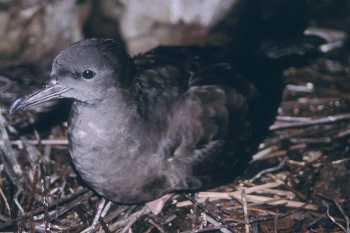The Wedge-tailed Shearwater Puffinus pacificus has been identified as a possible candidate for listing within the Albatross and Petrel Agreement (click here). In a recently-published study in the journal Marine Ecology Progress Series Christopher Surman (Halfmoon Biosciences, Ocean Beach, Australia) and colleagues have found that Australian "Wedgies' breed poorly during ENSO (El Niño Southern Oscillation) events.
The paper's abstract follows:
We compared 20 yr of seabird breeding data with oceanographic variables (sea level, sea-surface temperature) and a climate index (Southern Oscillation Index; SOI) for the lesser noddy Anous tenuirostris, brown noddy A. stolidus, sooty tern Onychoprion fuscata and wedgetailed shearwater Ardenna pacifica at the Houtman Abrolhos, eastern Indian Ocean. We found that timing of breeding and performance of these species is related to climate variability, mediated by oceanographic conditions within the eastern boundary Leeuwin Current (LC). The 3 migratory species have breeding parameters which are correlated with sea level and the SOI, while the first egg date of the resident lesser noddy is correlated with SST during their pre-breeding phase. There was poor breeding performance for each species during El Niño Southern Oscillation (ENSO) conditions; moreover, poor breeding success was recorded for all species outside of ENSO events in the latter years of the study. In addition, breeding was delayed for all species during the time of the present study. The environmental conditions contributing to this appear to be fewer years of strong LC flow with associated high sea levels, warmer SSTs, stronger eddy energy and increased productivity. Migratory seabird species breeding at this location appear less able to respond to climate variability - and its influence upon prey availability - than the resident species. It is suggested that the resident lesser noddy may have an advantage due to its response to a localised environmental cue, SST, in the pre-breeding phase, which may be correlated with prey availability in the waters surrounding the Houtman Abrolhos."

Wedge-tailed Shearwater. Photograph by Alan Burger
Reference:
Christopher A. Surman, C.A., Nicholson, L.W., & Santora, J.A. 2012. Effects of climate variability on breeding phenology and performance of tropical seabirds in the eastern Indian Ocean. Marine Ecology Progress Series 454: 147-157.
Note: The larger shearwaters in the genus Puffinus have been placed in the genus Ardenna by some authorities; others prefer to treat Ardenna as a subgenus of Puffinus. Click here if you wish to know more.
John Cooper, ACAP Information Officer, 21 June 2012

 English
English  Français
Français  Español
Español